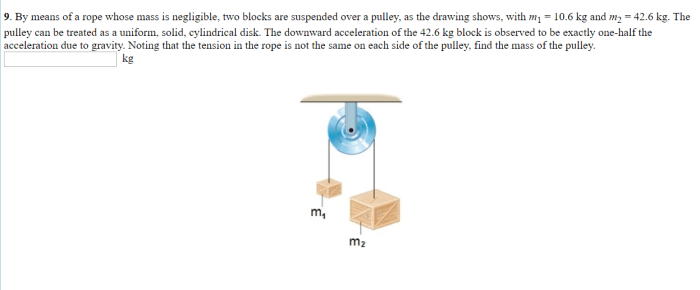By means of a rope whose mass is negligible, this discourse delves into the intriguing realm of rope dynamics, exploring the profound implications of negligible mass on rope behavior. Delving into the nuances of rope mechanics, we unravel the intricate relationship between mass, tension, and sag, revealing the significance of negligible mass in various engineering and physics applications.
From unraveling the mathematical underpinnings of rope dynamics to dissecting the safety considerations and limitations associated with ropes of negligible mass, this exploration unveils the complexities of this fascinating subject.
Properties of a Rope with Negligible Mass: By Means Of A Rope Whose Mass Is Negligible

In the context of rope dynamics, the assumption of negligible mass is often made. This concept implies that the mass of the rope is so small compared to the forces acting on it that its influence on the system can be disregarded.
This assumption simplifies the analysis of rope behavior and provides valuable insights into its mechanical properties.
Effects on Rope Tension and Sag
Negligible mass significantly affects the distribution of tension along the rope. When the mass is negligible, the tension is primarily determined by the external forces acting on the rope, such as the weight of the suspended load or the applied force.
The absence of significant mass means that the rope’s own weight does not contribute to the tension, resulting in a more uniform tension distribution.
Moreover, negligible mass influences the sag of the rope. Sag refers to the vertical deflection of the rope between its endpoints. When the mass is negligible, the sag is primarily influenced by the tension and the length of the rope.
The lack of significant mass reduces the gravitational pull on the rope, resulting in a smaller sag compared to ropes with non-negligible mass.
Applications in Engineering and Physics
The assumption of negligible mass finds practical applications in various engineering and physics domains. For instance, in suspension bridges, the mass of the cables is often considered negligible compared to the weight of the bridge deck and traffic load. This assumption simplifies the design and analysis of the bridge structure, allowing engineers to focus on the primary load-bearing components.
In physics experiments, negligible mass is often assumed when studying wave propagation and vibration phenomena. By disregarding the mass of the rope, researchers can isolate and analyze the effects of tension and elasticity on the wave’s behavior.
Mathematical Modeling and Analysis
To mathematically represent a rope with negligible mass, we can employ the following model:
T = F- mg
S = (WL^2) / (8T)
where T is the tension in the rope, F is the external force applied, m is the mass of the rope per unit length (assumed negligible), g is the acceleration due to gravity, W is the weight of the suspended load, L is the length of the rope, and S is the sag.
This model enables us to analyze the relationship between tension, length, and sag, providing valuable insights into the behavior of a rope with negligible mass.
Safety Considerations and Limitations, By means of a rope whose mass is negligible
While the assumption of negligible mass can simplify analysis, it is crucial to consider safety precautions when working with ropes. In practical applications, ropes may not always have negligible mass, and their weight can contribute to the overall system behavior.
It is essential to assess the mass of the rope relative to the forces involved and take appropriate safety measures.
Furthermore, the assumption of negligible mass may not be valid in certain situations, such as when the rope is very long or when the external forces are relatively small. In these cases, the mass of the rope can have a significant impact on the system’s dynamics and should be taken into account.
FAQs
What is the significance of negligible mass in rope dynamics?
Negligible mass in rope dynamics simplifies calculations and enables the analysis of rope behavior under various conditions, providing valuable insights for engineering design and physics experiments.
How does negligible mass affect rope tension?
Negligible mass reduces the tension in a rope, as the mass of the rope itself contributes minimally to the overall tension.
What are some practical applications of ropes with negligible mass?
Ropes with negligible mass find applications in suspension bridges, cable cars, and various lifting and pulling mechanisms, where minimizing weight is crucial.

